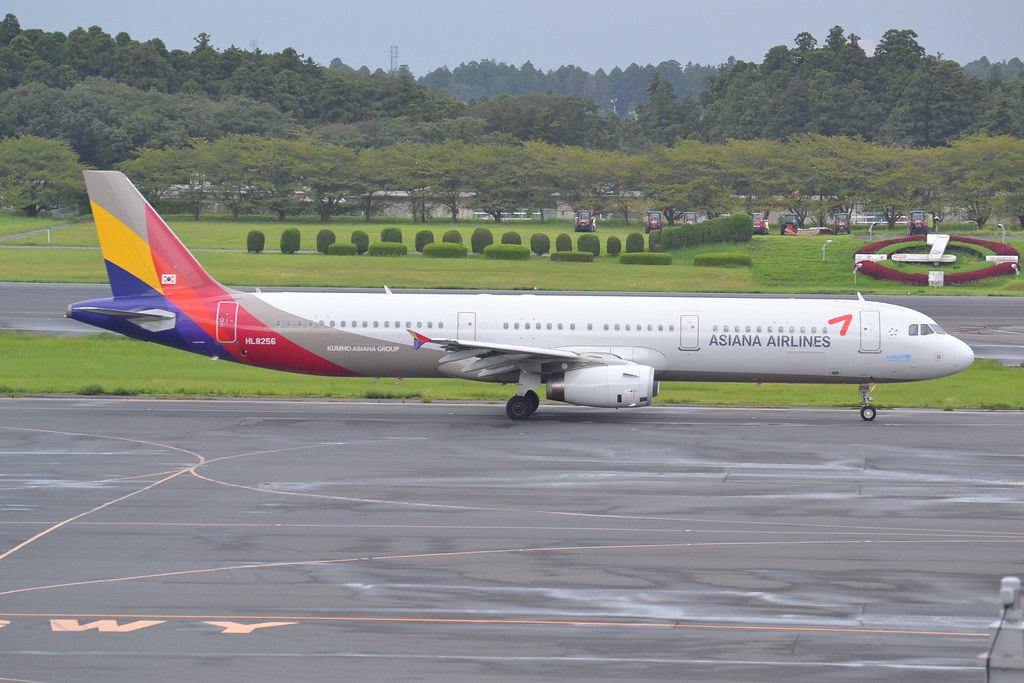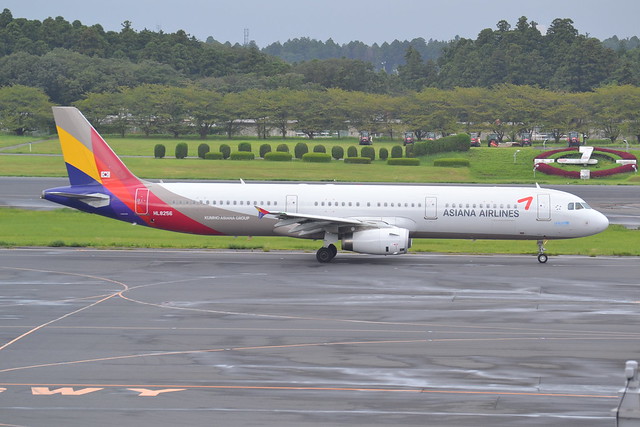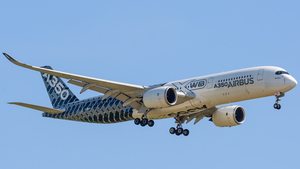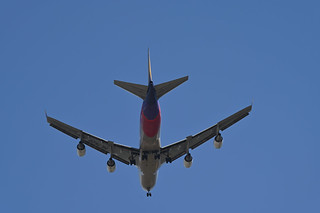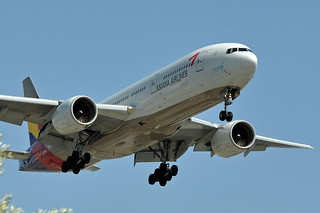Asiana A321 at Okinawa on Jul 21st 2019, runway incursion
Last Update: January 29, 2021 / 19:38:04 GMT/Zulu time
Incident Facts
Date of incident
Jul 21, 2019
Classification
Incident
Cause
Runway incursion
Airline
Asiana Airlines
Flight number
OZ-171
Departure
Okinawa, Japan
Destination
Seoul, South Korea
Aircraft Registration
HL8256
Aircraft Type
Airbus A321
ICAO Type Designator
A321
A Japan Transocean Boeing 737-800, registration JA01RK performing flight NU-212 from Kume-Jima to Okinawa (Japan), was on final approach to Okinawa's runway 18 descending through about 600 feet about 2nm before touchdown, when HL8256 taxied past the hold short line and entered runway 18.
Tower instructed NU-212 to go around, the crew complied and went around. NU-212 climbed to 4000 feet, positioned for another approach and landed safely on runway 18 about 20 minutes later.
OZ-171 departed about 2 minutes after the go around.
Japan's TSB opened an investigation into the occurrence.
On Jan 29th 2021 the JTSB released their final report referring to Asiana's A321 as Aircraft A and the Transocean Boeing as Aircraft B and concluding the probable causes of the serious incident were:
It is highly probable that this serious incident occurred because Aircraft A entered the runway despite of being instructed to hold short of Runway 18, when Aircraft B, which were cleared to land by the Tower, attempted to land at the same runway.
Regarding the fact that Aircraft A entered the runway, it is probable that when the PIC A received the ATC instruction, he mistook the Towerfs instruction to hold short of runway as the instruction to line up and wait, and his misunderstanding was not corrected.
It is probable that the reason why the PIC Afs misunderstanding was not corrected is because the PIC A and the FO A did not cross-check the ATC clearance, as specified in the Company Afs manual.
The JTSB summarized the sequence of events:
The departure of Aircraft A was 10 minutes behind the schedule.
As the taxing distance from D1 to E1 is short and the take-off preparation should be made during the taxiing at this short distance, the PIC A taxied at low speed. On Taxiway A1 (see Figure 3), there was a departure aircraft heading to Taxiway E0 (hereinafter referred to as gE0h) (see Figure 3) for take-off, but the Ground informed that Aircraft A would taxi firstly and instructed Aircraft A to communicate with the Tower.
Aircraft A communicated with the Tower. The take-off from E1 is an intersection departure (see 2.7 (1)), but Aircraft A was not asked to provide the consent on the intersection departure from the Tower, therefore, the PIC A checked the chart regarding the taxiway in use. However, there was no listed information on the intersection departure at Naha Airport. Therefore, the PIC A double-checked the chart, thinking that E1 might be eventually connected to E0, and Aircraft A would probably take off from the end of the runway.
To Aircraft A approaching E1, the Tower issued at once the two instructions of gHOLD SHORT OF RUNWAYh and gREVISED CLEARANCE, MAINTAIN FLIGHT LEVEL 250 ALTITUDE RESTRICTIONS CANCELLEDh related to the Standard Instrument Departure (SID)*4 (around 13:13:00).
The FO A stopped conducting the procedures for take-off, and responded by saying gREVISED MAINTAIN FLIGHT LEVEL 250 ALL ALTITUDE CANCELLED, CONFIRM E1 THEN HOLDING POINT RWY 18,h and read back with the term gE1 HOLDING SIHORT OF RWY 18, MAINTAIN FLIHGT LEVEL 250 ALL ALTITUDE RESTRICTIONS CANCELLEDh after receiving a response from the Tower saying gAFFIRM E1 HOLD SHORT OF RWY.h
At this time, the PIC A mistakenly perceived that he was instructed to gLINE UP AND WAITh. On the other hand, the FO A resumed the procedures for take-off, and after the completion of the procedures, he was changing the setting of the FMS* 5 related to the cancelled altitude restrictions in accordance with ATC instructions. Seeing what the FO A was doing, the PIC A continued taxing at further reduced speed. They did not cross-check the ATC clearance that should be done by flight crew, as specified in the Company Afs manual.
On the other hand, the Tower issued the landing clearance to the Aircraft B on the final approach (around 13:13:29).
The PIC A did not listen to the landing clearance issued to the Aircraft B on the final approach.
Aircraft A made incursion into Runway 18 from E1 without receiving ATC instruction (around 13:13:59)
At this time, the position of the Aircraft B was about 1.8 nm from the threshold of Runway 18 and at an altitude of about 600 ft.
The PIC A saw the final approach course when entering the runway, but was not able to find the Aircraft B. The FO A did not monitor the location of the aircraft and external environment as he was changing the setting of the FMS. Aircraft B was ready to execute a go-around as seeing Aircraft A entering the runway from E1.
Before the runway occupancy monitoring function of the ARTS (Automated radar terminal system) works, the Tower instructed Aircraft B to execute a go-around (around 13:14:04) as noticing that Aircraft A was entering the runway, and the Aircraft B executed a go-around. The Tower instructed Aircraft A to wait at the current position (around 13:14:07).
At this time, the Runway Entrance Lights (REL) turned on.
gWe did not receive instruction to enter the runway,h the FO A said to the PIC A after reading back the instruction from the Tower. The PIC A confirmed with the Tower about whether the instruction obtained by Aircraft A was to gLINE UP AND WAIT.h The Tower responded that it was the instruction of gHOLD SHORT OF RUNWAYh and Aircraft A read back the same content as this instruction. gOH, SORRY ABOUT THAT," the PIC A informed the Tower after hearing this response.
As there was some time interval until the next aircraft would arrive, the Tower issued the take-off clearance to Aircraft A. Aircraft A read it back and commenced its take-off.
After that, Aircraft B, which had executed a go-around, landed at Runway 18 by radar vectoring.
The Asiana Captain (38, ATPL, 6,178 hours total, 4,561 hours on type) was assisted by a first officer (35, CPL, 504 hours total, 200 hours on type).
The JTSB reported the weather: "The regular aerodrome meteorological report at the Airport around the time of the serious incident was as follows: 13:00 Wind direction; 180‹, Wind velocity; 11 kt, Prevailing visibility; More than 10 km Cloud: Amount 2/8; Type Cumulus; Cloud base 2,200 ft Temperature 32Ž, Dew point 25Ž Altimeter setting (QNH) 29.82 inHg"
The JTSB analysed:
It is probable that because in addition to the fact that the aircraft had a malfunction, their aircraft was to taxi firstly, the PIC A was paying too much attention to changing the flight plan entailed in the reconfirmation of the taxiway and the cancelled altitude restrictions while taxing in the short distance to the runway. During this time, it is somewhat likely that the PIC A mistook the Towerfs instruction to gHOLD SHORT OF RUNWAYh as the instruction to gLINE UP AND WAIT.h
It is probable that the FO A correctly understood the ATC instruction from the Tower since he rightly read back the Towerfs instruction to gHOLD SHORT OF RUNWAY.h However, it is probable that because the FO A had a lot of works to do such as conducting remained take-off procedures and changing the FMS settings entailed in the cancelled altitude restrictions after his read-back, he was not able to cross-check the ATC instruction and did not notice their making incursion into Runway 18.
It is probable that not cross-checking the ATC instruction, the misunderstanding made by the PIC A could not be corrected before Aircraft A entered the runway. It is also probable that because the PIC Afs misunderstanding was not corrected, Aircraft A made incursion into Runway 18.
It is imperative that no matter what the circumstances, flight crew should cross-check ATC instructions, it is all the more so without fail when their workload is at a high level.
The PIC A should not have entered the runway until he had finished cross-checking the ATC instruction.
In recognition of the role as the PM, the FO A should have always monitored the aircraft condition even while conducting the procedures he was responsible for.
In addition, if the take-off preparation has not completed when the aircraft gets at the runway holding position, flight crew should have informed the Tower as soon as possible.
It is highly probable that the Tower recognized visually that Aircraft A was beyond the hold line on E1, and therefore instructed Aircraft B, which had already approached around 1.8 nm from the threshold of Runway 18, to execute a go-around.
It is important that both the PF and the PM (PNF) should agree upon the acceptance of ATC clearances as described in the ICAO manual on the prevention of runway incursions, in multi-crew flight operation.
At the Airport, when Runway 18 is in use, departing aircraft may be instructed intersection departure from E1 without pilotfs consent, however, it is probable that because the PIC A did not know about the procedures, he was required to reconfirm the taxiway.
When Aircraft A made incursion into Runway 18 and Aircraft B executed a go-around according to the Towerfs instruction, the distance between Aircraft A and Aircraft B was approximately 3,334 m. The serious incident comes under the severity classification of Category C (An incident characterized by ample time and/or distance to avoid a collision) of gthe Manual on the Prevention of Runway Incursionsh of ICAO with classification tools provided by ICAO. (See Attachment: Severity Classifications of Runway Incursions).
Incident Facts
Date of incident
Jul 21, 2019
Classification
Incident
Cause
Runway incursion
Airline
Asiana Airlines
Flight number
OZ-171
Departure
Okinawa, Japan
Destination
Seoul, South Korea
Aircraft Registration
HL8256
Aircraft Type
Airbus A321
ICAO Type Designator
A321
This article is published under license from Avherald.com. © of text by Avherald.com.
Article source
You can read 2 more free articles without a subscription.
Subscribe now and continue reading without any limits!
Read unlimited articles and receive our daily update briefing. Gain better insights into what is happening in commercial aviation safety.
Send tip
Support AeroInside by sending a small tip amount.
Related articles
Asiana A321 at Daegu on May 26th 2023, emergency exit opened in flight
An Asiana Airlines Airbus A321-200, registration HL8256 performing flight OZ-8124 from Jeju to Daegu (South Korea) with 194 people on board, had been…
Asiana A333 at Seoul on Jun 21st 2025, engine problem
An Asiana Airlines Airbus A330-300, registration HL8286 performing flight OZ-108 from Seoul (South Korea) to Tokyo Narita (Japan) with 263 people on…
Asiana A359 at San Francisco on Feb 23rd 2025, low altitude alert on final approach
An Asiana Airbus A350-900, registration HL8382 performing flight OZ-212 from Seoul (South Korea) to San Francisco,CA (USA), was on final approach to…
Asiana A333 at Chiang Mai on Jan 24th 2025, rejected takeoff due to engine anomaly
An Asiana Airbus A330-300, registration HL7747 performing flight OZ-766 from Chiang Mai (Thailand) to Seoul (South Korea), was accelerating engines…
Asiana B744 at San Francisco on Jan 24th 2024, sparks seen from aircraft
An Asiana Boeing 747-400 freighter, registration HL7420 performing flight OZ-285 from San Francisco,CA (USA) to Seoul (South Korea), was climbing out…
Asiana B772 at Singapore on Nov 16th 2023, engine shut down in flight
An Asiana Boeing 777-200, registration HL7700 performing flight OZ-754 from Singapore (Singapore) to Seoul (South Korea) with 279 people on board,…
Newest articles
India Express B738 at Ras al-Khaimah on Apr 22nd 2025, tail strike on landing
An Air India Express Boeing 737-800, registration VT-AXZ performing flight IX-331 from Khozikode (India) to Ras al-Khaimah (United Arab Emirates),…
Delta A321 near Kansas City on Jan 3rd 2026, engine shut down in flight
A Delta Airlines Airbus A321-200, registration N349DX performing flight DL-2883 from Denver,CO to Detroit,MI (USA) with 169 passengers and 6 crew,…
Subscribe today
Are you researching aviation incidents? Get access to AeroInside Insights, unlimited read access and receive the daily newsletter.
Pick your plan and subscribePartner

ELITE Simulation Solutions is a leading global provider of Flight Simulation Training Devices, IFR training software as well as flight controls and related services. Find out more.
SafetyScan Pro provides streamlined access to thousands of aviation accident reports. Tailored for your safety management efforts. Book your demo today
AeroInside Blog
Popular aircraft
Airbus A320Boeing 737-800
Boeing 737-800 MAX
Popular airlines
American AirlinesUnited
Delta
Air Canada
Lufthansa
British Airways
